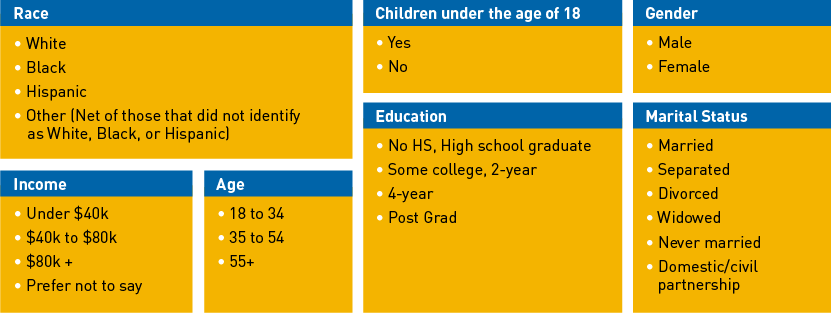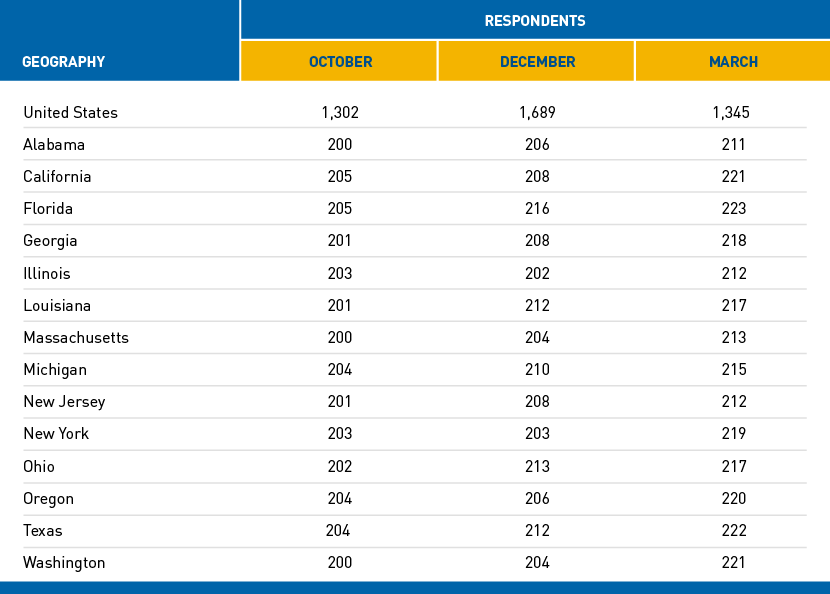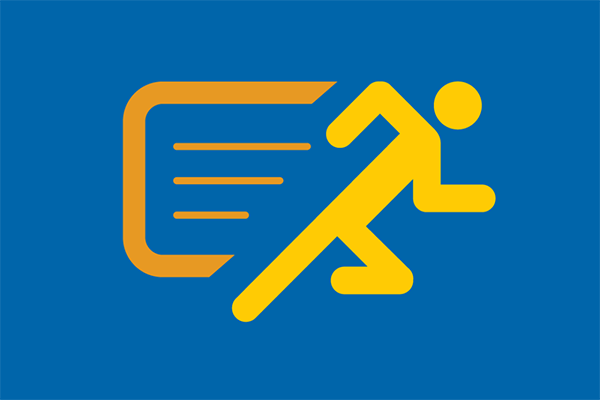Pandemic Polling Methodology
This page contains the methodology for the polls (also referred to as surveys) conducted for the Healthcare Ready project, Impact of COVID-19 on Communities of Color. For general information about the project, visit the project main page here or see our Frequently Asked Questions.
Survey Administration
We worked with YouGov, an international research data and analytics group, to carry out the surveys for this project. Surveys were conducted by YouGov using an online interview administered to members of YouGov PLC’s panel of individuals who have agreed to take part in surveys. Emails were sent to panelists selected at random from the base sample. The e-mail invited them to take part in a survey and provided a generic survey link.
Survey Questions and Answers
The questions we asked, and the answer options for each question, listed in full below. The questions are listed in the order they were asked. Any bolding below reflects the actual appearance of poll text as presented to respondents.
1. Thinking about March 2020* to now, how much, if at all, has COVID or coronavirus changed you or your household’s situation in the following areas? Please select one option on each row.
Answer options per row:
- Got much worse
- Got a little worse
- No change
- Got a little better
- Got a lot better
- Not applicable – this does not apply to me
Rows:
- Ability to pay for medicines or medical treatments
- Ability to get medicines or medical treatments (e.g., getting to the doctor, filling prescriptions, etc.)
- Ability to pay for food or other basic expenses
- Employment situation (e.g., losing your job, changes in hours, etc.)
- Emotional or mental health
- Childcare and/or child education situation
- Caretaking responsibilities (e.g., taking care of a family member)
- Housing situation (e.g., having a stable place to live)
- Challenges with use of/reliance on technology (e.g., using the internet, video meetings, etc.)
2. Thinking about March 2020* to now, which ONE of these has negatively affected you or your household the MOST? Please select the option that best applies.
- Ability to pay for medicines or medical treatments
- Ability to get medicines or medical treatments (e.g., getting to the doctor, filling prescriptions, etc.)
- Ability to pay for food or other basic expenses
- Employment situation (e.g., losing your job, changes in hours, etc.)
- Emotional or mental health
- Childcare and/or child education situation
- Caretaking responsibilities (e.g., taking care of a family member)
- Housing situation (e.g., having a stable place to live)
- Challenges with use of/reliance on technology (e.g., using the internet, video meetings, etc.)
3. Thinking about March 2020* to now, which, if any, of the following challenges have you or your household tried to get help with because of COVID or coronavirus? Please select all that apply.
- Ability to pay for medicines or medical treatments
- Ability to get medicines or medical treatments (e.g., getting to the doctor, filling prescriptions, etc.)
- Ability to pay for food or other basic expenses
- Employment situation (e.g., losing your job, changes in hours, etc.)
- Emotional or mental health
- Childcare and/or child education situation
- Caretaking responsibilities (e.g., taking care of a family member)
- Housing situation (e.g., having a stable place to live)
- Challenges with use of/reliance on technology (e.g., using the internet, video meetings, etc.)
- Not applicable – I have not tried to get help with any of these challenges
4. Which, if any, of the following challenge(s) do you still need help with now? Please select all that apply.
- Ability to pay for medicines or medical treatments
- Ability to get medicines or medical treatments (e.g., getting to the doctor, filling prescriptions, etc.)
- Ability to pay for food or other basic expenses
- Employment situation (e.g., losing a job, changes in hours, etc.)
- Emotional or mental health
- Childcare and/or child education situation
- Caretaking responsibilities (e.g., taking care of a family member)
- Housing situation (e.g., having a stable place to live)
- Challenges with use of/reliance on technology (e.g., using the internet, video meetings, etc.)
- Not applicable – I currently do not need help with any of these challenges
5. Thinking about March 2020* to now, which, if any, of these barriers has stopped you or your household from getting help during COVID or coronavirus? Please select all that apply.
- I/we were unsure what kind of help is available
- I/we were unsure who (which groups, agencies, or organizations) can provide the help I/we need
- I/we don’t believe an organization will help me/us
- Worried that I’ll/we’ll be treated poorly or disrespectfully by the people I/we would go to for help
- I/we’re worried friends/family/my community will judge me/us
- Fear that I or others in my household might get sick
- Health insurance problems (e.g., no insurance, not enough insurance, etc.)
- Unable to afford what I/we need
- Not applicable – I/we have not experienced any challenges due to the Coronavirus
- Not applicable – I/we have experienced challenges due to the Coronavirus, but have not needed help because of them
6. How much help, if any, have you and your household received from the following sources during COVID or coronavirus? Please select one option on each row.
- The federal government, like FEMA or HHS (for help like stimulus checks, rental assistance like Section 8, EBT or food stamps, etc.)
- State or local government agencies, like the public school system or public health department (for help like community COVID testing, unemployment assistance, etc.)
- Community organizations, non-profit organizations, and faith-based organizations, like churches or the YMCA (for help like emotional or mental health support, getting food or supplies, etc.)
- An employer (for help like cash advances, family and medical leave, manager support, etc.)
- A school or university
- Family members or friends
- Neighbors
7. Thinking about the next two years. which of the following do you think will be the biggest challenges for you or your household? Please select the TWO options that best apply.
- Ability to pay for medicines or medical treatments
- Ability to get medicines or medical treatments (e.g., getting to the doctor, filling prescriptions, etc.)
- Ability to pay for food or other basic expenses
- Employment situation (e.g., losing a job, changes in hours, etc.)
- Emotional or mental health
- Childcare and/or child education situation
- Caretaking responsibilities (e.g., taking care of a family member)
- Housing situation (e.g., having a stable place to live)
- Challenges with use of/reliance on technology (e.g., using the internet, video meetings, etc.)
- Not applicable – I do not believe I/we will face any of these challenges in the next two years
8. Thinking about the next two years (i.e., until October 2022), which source(s), if any, do you believe you and your household will need help from? Please select all that apply.
- The Federal government, like FEMA or HHS (for help like stimulus checks, rental assistance like Section 8, EBT or food stamps)
- State or local government agencies, like the public school system or public health department (for help like community COVID testing, unemployment assistance, etc.)
- Community organizations, non-profit organizations, and faith-based organizations, like churches or the YMCA (for help like emotional or mental health support, getting food or supplies, etc.)
- An employer (for help like cash advances, family and medical leave, manager support, etc.)
- A school or university
- Family members or friends
- Neighbors
- Not applicable – I do not think I/we will need help from any of these sources over the next two years
*: In October and December national polls, respondents were asked to consider March 2020 to the time of polling. In March, they were asked to consider July 2020 to the time of polling.
Demographics

Analysis
All analysis was completed based on weighted figures. Weighting was calculated by YouGov to ensure samples were representative of each poll geography’s adults (aged 18+). That is, national poll results are representative of all US adults; Louisiana poll results are representative of all Louisiana adults, etc.
We performed descriptive comparative analysis of results across months by comparing the percent of respondents who chose a certain answer in one month compared to the others.
We also performed statistical analysis using proportion t-tests to understand if there were statistical differences between demographic groups. The p-values for proportion t-tests were completed automatically in YouGov’s online statistical program, Crunch. Every combination of demographic comparisons was completed – for example, for Race, the following proportions were compared for every question response:
- White – Black
- White – Hispanic
- White – Other
- Black – Hispanic
- Black – Other
- Hispanic – Other
Results were considered significant at the level p < 0.05. Statistical testing was only completed in cases in which the demographic base was at least 50 individuals.
More detailed information regarding statistical testing methods will be posted here at a later date.
Sample Sizes

Polling Timing

Limitations
There were limitations with the study design that may have impacted some results. First, because surveys were conducted online and in English, the sample population was limited to those individuals with internet access and English proficiency. For this reason, there may be some bias in responses to in certain questions, particularly those related to technology, access to assistance, and barriers to getting assistance. This is because the sample population, by virtue of being able to complete an online, English language survey, may not face barriers related to technology or language that others in the US likely face.
Another limitation of our polling was the relatively limited demographics categories available to respondents, particularly for race. The categories were: White, Black, Hispanic, and an Other. Other included any other non-White respondents that did not identify as Black or Hispanic. As a result, the Other category represents multiple disparate groups that were undefined by the poll, including: Asian Americans, Native Hawaiians and Pacific Islanders, and American Indian/indigenous populations. In addition, as Hispanic is an ethnic identification instead of racial, Latinx respondents who do not identify as Hispanic may have chosen another option; in our analysis we largely treat Hispanic respondents as Latinx. Finally, since respondents were only able to select one option for race, there were likely instances in which respondents who identify with more than one group had to limit their choice to one option. Gender was also a demographic with a limitation; the two options available to respondents were either Male or Female. We are working with the survey administrators to broaden these options for future studies.
Even with these limitations, we believe the groups sampled allow us to draw useful and important conclusions regarding how Americans, including those within different demographic groups, were impacted by the COVID-19 pandemic.
Citing the Data
To cite this work, please use the following citations:
Analysis
Please use the following citation structure for any reference to Healthcare Ready analysis webpages.
Healthcare Ready. The Impact of COVID-19 on Communities of Color – [INSERT TITLE OF WEBPAGE CITED] 2021. Web. Available from: [LINK]
Data
Please use the following citations for any reference to IC3 data dashboards.
National
- Healthcare Ready/YouGov. The Impact of COVID-19 on Communities of Color – October National Poll. 2020. Available from: https://healthcareready.org/covid19/equity/data/us/
- Healthcare Ready/YouGov. The Impact of COVID-19 on Communities of Color – December National Poll. 2020. Available from: https://healthcareready.org/covid19/equity/data/us/
- Healthcare Ready/YouGov. The Impact of COVID-19 on Communities of Color – March National Poll. 2021. Available from: https://healthcareready.org/covid19/equity/data/us/
COVID-19 and Equity Project
Read more about our work on equity during the pandemic: COVID-19: Equitable Response and Recovery






